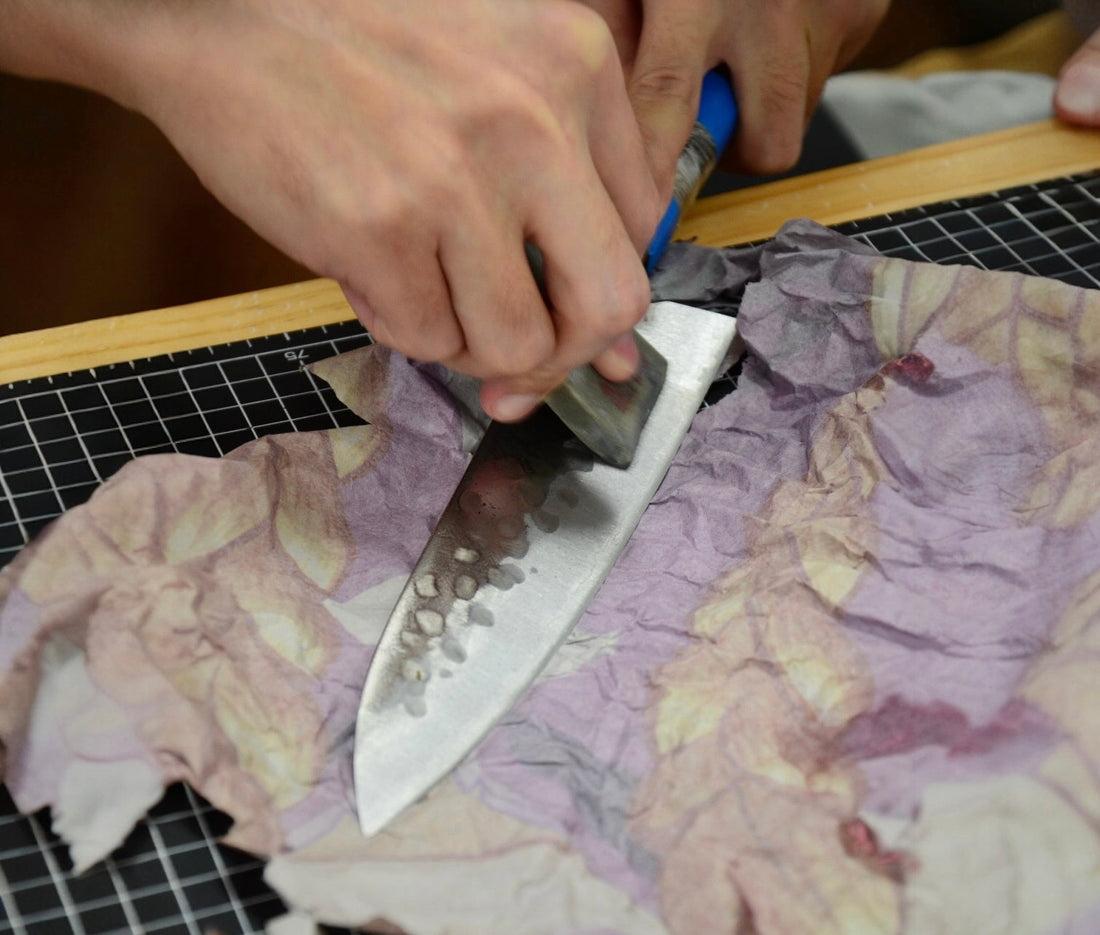TLDR - The Essentials
Step 1 - Washing
Wash the blade thoroughly and ensure all food particles, oils, and cleaning solutions are removed before drying. Any leftover acids or alkalines can both cause negative reactions with the knife steel as well as interfere with any knife oils that will be put on at the later steps.
Step 2 - Drying
Wipe off any excess water with a clean towel and leave the knife to air dry in a ventilated area for 15 minutes before moving onto the next step.
Step 3 - Oiling
After drying, coat the blade with Camellia Oil or food grade mineral oil before storage. The oil will act as a barrier between the knife steel and the moisture/humidity in the environment, to prevent rusting.
NOTE: If the blade is not fully dried, do not oil. The oil will instead trap the moisture onto the blade, causing deep rusting.
TLDR - How to Deal with Light Rust
Step 1:
Mix a little water and baking soda into a thick paste.

Step 2:
Using a cloth and your fingers, lightly massage the paste onto the area of rust. The paste should remove the rust without scratching the steel if you use light pressure.

Step 3:
Rinse the blade and repeat as needed. Black spots may be left on the blade after rust removal. This is normal, as the black spots are black iron oxide (magnetite) which forms as a normal part of the patina process.
Step 4:
Wash off any excess baking soda, and follow the TLDR guide to wash, dry and oil your blade.


The Details - Carbon Steel Knife Maintenance
Carbon steel knives provide unique advantages over their stainless steel counterparts. They are generally easier to sharpen and tougher than most other Japanese stainless steel blades. When sharpened correctly, cutting with carbon steel is often more enjoyable with a distinctive and aggressive cutting feedback.
However, preventing rust on carbon steels can be tricky, especially in humid countries like Singapore. Despite this, we’ve found that with proper care and preventive maintenance, there are ways to keep carbon steel knives in tip-top condition regardless of the conditions of where you live.
We have gathered some pointers and compiled them in this short but insightful post to help everyone get started in taking care of their carbon steel knives.
Washing:
Often times when our customers return their knives to us for sharpening or maintenance, we see bits of food or grease still left on the knife.
Apart from harboring bacteria, improper cleaning can lead to rusting as leftover food particles can trap moisture and slow down the drying process of the knife. If left unchecked, the rust can eat into the material and cause pitting which cannot be fixed without resanding the entire blade.
To avoid this, we often advise to wash the knife thoroughly immediately after use. This will prevent any food particles from adhering strongly to the blade. A simple wash with some dish soap and a non-abrasive sponge should easily remove all food particles.
If there are any stubborn food particles remaining, a plastic brush should be used to brush them off before washing with the sponge.
Keep the knife dry:
After washing, it is essential to dry the knife off completely. As carbon steel reacts to moisture, any leftover droplets of water - no matter how big or small - can greatly increase the chances of rusting.
Once you dry the knife off with a clean towel, it is important to let the knife air dry as well.
Leave the knife to air dry in a ventilated area for 15 minutes to let all the remaining moisture evaporate. This is to let any trace amounts of moisture evaporate from the microscopic nooks and crannies of the knife.
This is usually why many high end Japanese knife makers mirror polish their knives as this can greatly help to reduce the microscopic grooves where water can sit.
Storage:
After thoroughly drying the knife, it is important to oil it before storage. This is because the humidity in the air can also cause carbon steel knives to rust over time.
Using a thin layer of protective Camellia Oil, coat the entire surface of the carbon steel blade once it's fully dried. The oil prevents the steel from interacting with the humidity in the environment.
It is important to oil the knives when they are completely dry. While the oil can create a moisture barrier between the knife and the environment, it can also trap any remaining water that is left on the blade from cleaning, which would be counter productive.
You do not need to rinse off the oil before use, as it is food-grade and edible.
Rust:
If detected early enough, rust removal can be simple to do.
Using a thick paste of water and baking soda and light pressure, scrub the rusted areas in the direction of the blade’s scratch pattern. You can use a wine cork, a toothbrush for a damp cloth to aid with the scrubbing.
We find that if the baking soda is thoroughly mixed in the water it acts as a light abrasive that is not hard enough to scratch steel but can still remove rust.
However, there have been times where the baking soda we used was not fully dissolved, and it left light scratches on the blade. So make sure that when using this method, ensure that the baking soda is fully dissolved. If the rust doesn't come off the first time, try repeating the process a few times, rinsing in between each time. Always use light pressure to avoid scratches.
Severe Rust:
Deep rust can form when the knife is neglected or left wet for long periods of time. This can form pits and also form raised bumps of rust. In order to remove this, stronger abrasives are required.
Rust erasers are a convenient way to remove these severe rust spots as they are flexible enough to scrub out rust even inside pitted steel. Do note that rust erasers cannot remove pitted spots on your blade, they can only remove the rust inside the pits.
Since rust erasers are abrasive, they do leave scratches on your blade, so it would be advisable to use the rust eraser on the entire blade to achieve an even scratch pattern throughout.
To blend in the remaining scratches, a progression of sandpaper and polishing compound is required. However, aesthetic polishing and restoration of the blade finish are beyond the scope of this guide.

